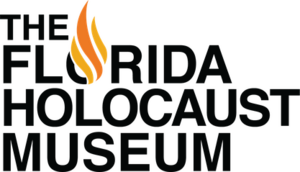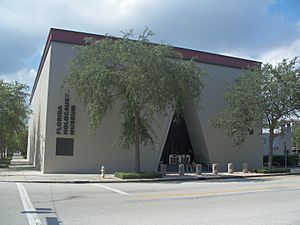Florida Holocaust Museum facts for kids
 |
|
 |
|
| Lua error in Module:Location_map at line 420: attempt to index field 'wikibase' (a nil value). | |
| Location | St. Petersburg, Florida |
|---|---|
| Type | Holocaust museum |
The Florida Holocaust Museum is a special place located in St. Petersburg, Florida. It teaches people about the Holocaust, a terrible time in history. The museum opened in 1992 and moved to its current spot in 1998. It is one of the biggest Holocaust museums in the United States.
The museum was started by Walter and Edith Lobenberg. They were German Jews who escaped danger in Nazi Germany. They came to the United States to find safety. Elie Wiesel, a Holocaust survivor and Nobel Peace Prize winner, helped open the museum in 1998. The Florida Holocaust Museum is one of only three Holocaust museums in the U.S. that are officially recognized by the American Alliance of Museums. It works with the community to share stories and teach everyone about the Holocaust. This helps prevent similar events from happening again.
Contents
Museum History
Who Started the Museum?
Walter and Edith Loebenberg founded the Florida Holocaust Museum in 1992. Both were born in Germany and had to escape the Nazis. Walter Loebenberg faced danger in Germany. His family moved to Frankfurt in 1936. In 1938, during an event called Kristallnacht, Walter had to hide to stay safe.
With help from an aunt in the United States, Walter moved there. He later joined the United States Army in 1942. He served during World War II. After the war, Walter met Edith, and they married in 1948.
How the Museum Grew
The museum started as the Holocaust Center. Its goal was "teaching the members of all races and cultures the inherent worth and dignity of life." This was to prevent future terrible events. It began in a small rented space. The museum first showed a collection of 10 Holocaust posters.
Its first big exhibit was 'Anne Frank in the World'. This exhibit brought in 24,000 visitors in just one month. The center also offered classes, talks, and events. It gave schools study guides and training for teachers. Holocaust survivors also shared their stories.
By 1996, the museum needed more space. Its leaders decided to buy a larger building. This new building was a former bank. It was much bigger, with 27,000 square feet. The move was finished in 1998. In January 1999, the center officially became the Florida Holocaust Museum. Elie Wiesel was there for the opening ceremony in 1998.
The new museum welcomed 65,000 visitors in its first year. It has three floors. The first floor holds the main exhibit and historical records. The second and third floors have changing exhibits. A real boxcar, number 113 069-5, became a key part of the permanent collection. This boxcar once carried victims of the Nazis.
A Sad Event
On May 27, 2021, the museum's outside walls were sadly marked with hateful symbols and words. This event showed why the museum's message of tolerance and understanding is still so important today.
Museum Exhibits
Main Collection
The main collection is on the first floor. It is called "History, Heritage, and Hope." This exhibit has many items from the Holocaust time. Visitors can take an audio tour. It tells the story of the Holocaust. It starts with the history of antisemitism and life before World War II. Then it shows the rise of Hitler and the Nazis. It also explains how other groups were targeted.
The most important part of this collection is a real boxcar. It is boxcar #113 069-5 from Gdynia, Poland. This boxcar was used to transport people to concentration camps. It sits on original train tracks from the Treblinka Killing Center. It is a quiet reminder of those who were killed. The museum also displays art by Toby Knobel Fluek, an artist and Holocaust survivor.
Changing Exhibits
The second and third floors have temporary exhibits. These exhibits change often. They cover many topics. Some show artistic views of the Holocaust. Others teach about related events, like the Nuremberg Trials. The third floor also has a large open area. This space is used for talks and events.
One special exhibit is Dimensions in Testimony. Here, visitors can ask questions. Pre-recorded videos of Holocaust survivors answer in real-time. This amazing project uses advanced technology. Another exhibit is Matezevot for Everyday Use. It shows photos of Jewish tombstones. During the war, these tombstones were used to make other things. Many still have Hebrew writing on them. There is also Humanity behind Barbed Wire. This exhibit tells about German prisoners of war in Florida during World War II.
Museum Programs
The Florida Holocaust Museum offers many programs. These programs reach out to the community. They help spread awareness about human rights.
- Speak Up, Speak Now! This program helps students talk about important issues. It includes guest speakers. These speakers are Holocaust survivors, police officers, and activists.
- Anne Frank Humanitarian Award This award started in 2001. It honors high school juniors. These students show great kindness and help others.
- Law Enforcement And Society (LEAS) The museum teaches Florida police agencies. These lessons explain the role of German police in the Holocaust.
- Generations After This group includes children and grandchildren of Holocaust survivors. They share their families' stories.
Education at the Museum
Florida was one of the first states to require Holocaust education. This is for students in kindergarten through 12th grade. The museum played a big part in making this law in 1994.
The Florida Holocaust Museum sends speakers to schools. It also welcomes school classes to the museum. Teachers can borrow materials for free. These materials help them teach about the Holocaust. In 2014, these teaching kits reached 17 states. They helped educate about 50,000 people.
The museum also offers guided tours for school groups. These tours take about two hours. They are for students in fifth through twelfth grades. The museum also has free workshops for all Florida teachers. These workshops are held after school.
In response to COVID-19, the museum started a Virtual Education Outreach Program. This lets people learn from home.
Volunteer Opportunities
The Florida Holocaust Museum has volunteer programs. Young Austrians can also serve their Austrian Holocaust Memorial Service here.
See also
- Austrian Holocaust Memorial Service

